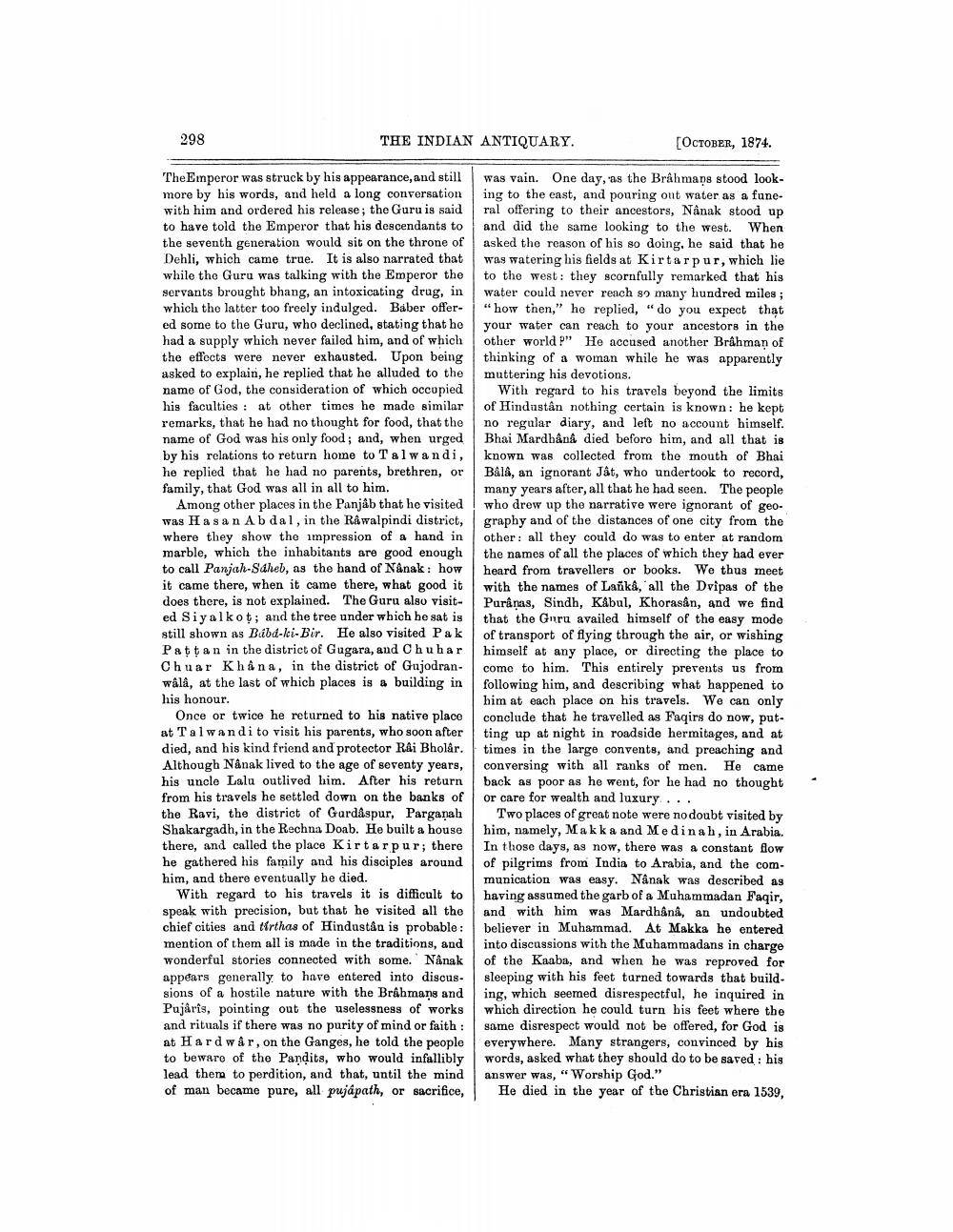________________
298
THE INDIAN ANTIQUARY.
The Emperor was struck by his appearance, and still more by his words, and held a long conversation with him and ordered his release; the Guru is said to have told the Emperor that his descendants to the seventh generation would sit on the throne of Dehli, which came true. It is also narrated that while the Guru was talking with the Emperor the servants brought bhang, an intoxicating drug, in which the latter too freely indulged. Baber offered some to the Guru, who declined, stating that he had a supply which never failed him, and of which the effects were never exhausted. Upon being asked to explain, he replied that he alluded to the name of God, the consideration of which occupied his faculties at other times he made similar remarks, that he had no thought for food, that the name of God was his only food; and, when urged by his relations to return home to Talwandi, he replied that he had no parents, brethren, or family, that God was all in all to him.
Among other places in the Panjâb that he visited was Hasan Ab dal, in the Rawalpindi district, where they show the impression of a hand in marble, which the inhabitants are good enough to call Panjah-Saheb, as the hand of Nanak: how it came there, when it came there, what good it does there, is not explained. The Guru also visited Siyalkot; and the tree under which he sat is still shown as Búábd-ki-Bir. He also visited P a k
Pattan in the district of Gugara, and Chuhar Chuar Khana, in the district of Gujodranwâlâ, at the last of which places is a building in his honour.
Once or twice he returned to his native place at Talwandi to visit his parents, who soon after died, and his kind friend and protector Rai Bholår. Although Nânak lived to the age of seventy years, his uncle Lalu outlived him. After his return from his travels he settled down on the banks of the Ravi, the district of Gurdaspur, Parganah Shakargadh, in the Rechna Doab. He built a house there, and called the place Kirtarpur; there he gathered his family and his disciples around him, and there eventually he died.
With regard to his travels it is difficult to speak with precision, but that he visited all the chief cities and tirthas of Hindustan is probable: mention of them all is made in the traditions, and wonderful stories connected with some. Nânak appears generally to have entered into discussions of a hostile nature with the Brahmans and Pujârîs, pointing out the uselessness of works and rituals if there was no purity of mind or faith: at Hardwar, on the Ganges, he told the people to beware of the Pandits, who would infallibly lead them to perdition, and that, until the mind of man became pure, all pujapath, or sacrifice,
[OCTOBER, 1874.
was vain. One day, as the Brâhmans stood looking to the east, and pouring out water as a funeral offering to their ancestors, Nânak stood up and did the same looking to the west. When asked the reason of his so doing, he said that he was watering his fields at Kirtarpur, which lie to the west: they scornfully remarked that his water could never reach so many hundred miles; "how then," he replied, "do you expect that your water can reach to your ancestors in the other world ?" He accused another Brahman of thinking of a woman while he was apparently muttering his devotions.
With regard to his travels beyond the limits of Hindustân nothing certain is known: he kept no regular diary, and left no account himself. Bhai Mardhânâ died before him, and all that is known was collected from the mouth of Bhai Bâlâ, an ignorant Jât, who undertook to record, many years after, all that he had seen. The people who drew up the narrative were ignorant of geography and of the distances of one city from the other: all they could do was to enter at random the names of all the places of which they had ever heard from travellers or books. We thus meet with the names of Lanka, all the Dvipas of the Puranas, Sindh, Kabul, Khorasan, and we find that the Guru availed himself of the easy mode of transport of flying through the air, or wishing himself at any place, or directing the place to come to him. This entirely prevents us from following him, and describing what happened to him at each place on his travels. We can only conclude that he travelled as Faqirs do now, putting up at night in roadside hermitages, and at times in the large convents, and preaching and conversing with all ranks of men. He came back as poor as he went, for he had no thought or care for wealth and luxury...
Two places of great note were no doubt visited by him, namely, Makka and Medinah, in Arabia. In those days, as now, there was a constant flow of pilgrims from India to Arabia, and the communication was easy. Nânak was described as having assumed the garb of a Muhammadan Faqir, and with him was Mardhânâ, an undoubted believer in Muhammad. At Makka he entered into discussions with the Muhammadans in charge of the Kaaba, and when he was reproved for sleeping with his feet turned towards that building, which seemed disrespectful, he inquired in which direction he could turn his feet where the same disrespect would not be offered, for God is everywhere. Many strangers, convinced by his words, asked what they should do to be saved: his answer was, "Worship God."
He died in the year of the Christian era 1539,




